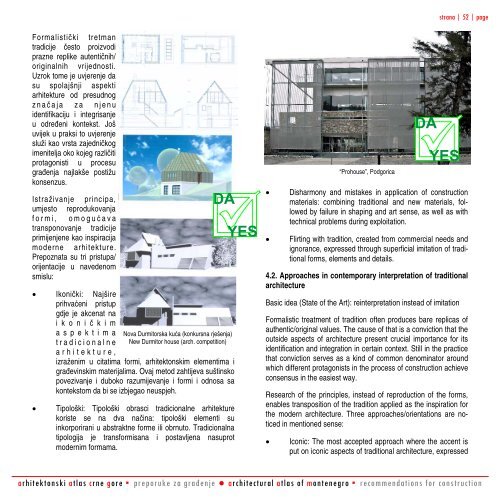arhitekonski atlas crne gore - Ada Bojana
arhitekonski atlas crne gore - Ada Bojana
arhitekonski atlas crne gore - Ada Bojana
You also want an ePaper? Increase the reach of your titles
YUMPU automatically turns print PDFs into web optimized ePapers that Google loves.
Formalistički tretman<br />
tradicije često proizvodi<br />
prazne replike autentičnih/<br />
originalnih vrijednosti.<br />
Uzrok tome je uvjerenje da<br />
su spolajšnji aspekti<br />
arhitekture od presudnog<br />
znač aja za njenu<br />
identifikaciju i integrisanje<br />
u određeni kontekst. Još<br />
uvijek u praksi to uvjerenje<br />
služi kao vrsta zajedničkog<br />
imenitelja oko kojeg različiti<br />
protagonisti u procesu<br />
građenja najlakše postižu<br />
konsenzus.<br />
Istraživanje principa,<br />
umjesto reprodukovanja<br />
formi, omoguć ava<br />
transponovanje tradicije<br />
primijenjene kao inspiracija<br />
moderne arhitekture.<br />
Prepoznata su tri pristupa/<br />
orijentacije u navedenom<br />
smislu:<br />
• Ikonički: Najšire<br />
prihvaćeni pristup<br />
gdje je akcenat na<br />
i k o n ič k i m<br />
aspektima<br />
tradicionalne<br />
arhitekture,<br />
Nova Durmitorska kuća (konkursna rješenja)<br />
New Durmitor house (arch. competition)<br />
izraženim u citatima formi, arhitektonskim elementima i<br />
građevinskim materijalima. Ovaj metod zahtijeva suštinsko<br />
povezivanje i duboko razumijevanje i formi i odnosa sa<br />
kontekstom da bi se izbjegao neuspjeh.<br />
• Tipološki: Tipološki obrasci tradicionalne arhitekture<br />
koriste se na dva načina: tipološki elementi su<br />
inkorporirani u abstraktne forme ili obrnuto. Tradicionalna<br />
tipologija je transformisana i postavljena nasuprot<br />
modernim formama.<br />
“Prohouse”, Podgorica<br />
strana | 52 | page<br />
• Disharmony and mistakes in application of construction<br />
materials: combining traditional and new materials, followed<br />
by failure in shaping and art sense, as well as with<br />
technical problems during exploitation.<br />
• Flirting with tradition, created from commercial needs and<br />
ignorance, expressed through superficial imitation of traditional<br />
forms, elements and details.<br />
4.2. Approaches in contemporary interpretation of traditional<br />
architecture<br />
Basic idea (State of the Art): reinterpretation instead of imitation<br />
Formalistic treatment of tradition often produces bare replicas of<br />
authentic/original values. The cause of that is a conviction that the<br />
outside aspects of architecture present crucial importance for its<br />
identification and integration in certain context. Still in the practice<br />
that conviction serves as a kind of common denominator around<br />
which different protagonists in the process of construction achieve<br />
consensus in the easiest way.<br />
Research of the principles, instead of reproduction of the forms,<br />
enables transposition of the tradition applied as the inspiration for<br />
the modern architecture. Three approaches/orientations are noticed<br />
in mentioned sense:<br />
• Iconic: The most accepted approach where the accent is<br />
put on iconic aspects of traditional architecture, expressed<br />
arhitektonski <strong>atlas</strong> <strong>crne</strong> <strong>gore</strong> ▪ preporuke za građenje ● architectural <strong>atlas</strong> of montenegro ▪ recommendations for construction



